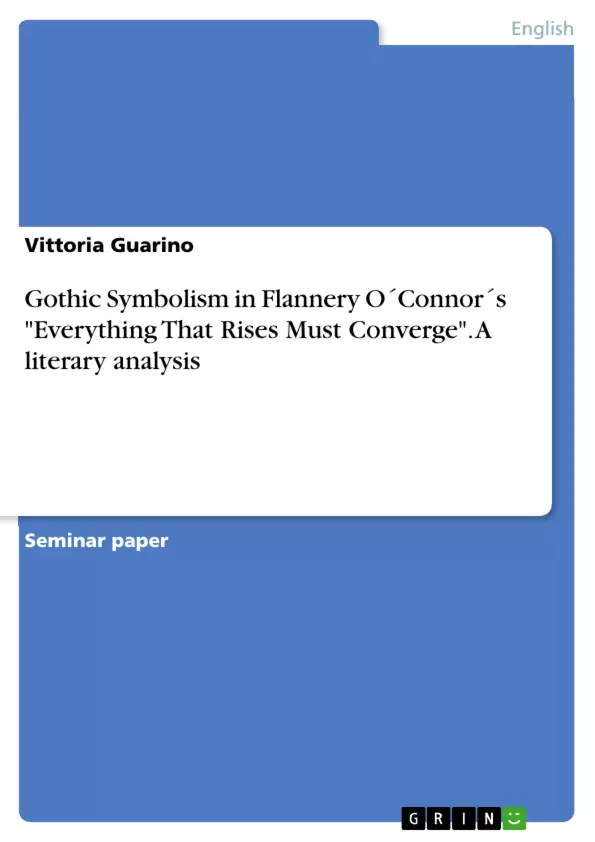Some of the allegories enclosed in the concrete symbols of "Everything That Rises Must Converge" have also occurred throughout the centuries under various similar forms in other Gothic fictions and are, therefore, considered to be typical Gothic motifs.
The examination of the symbolism in “ETRMC”, by unconvering its allegorical messages, appears to me to be of considerable interest in order to outline some traditional Gothic motifs which have been included in the story and which unleash its Gothic character.
The analysis will be structured, as follows: first I will define O´Connor´s conception of literary symbolism, second I will proceed by investigating the symbols corresponding to the motifs of the discomforting ambiance in the story and at last I will concentrate on the motif of the alter-ego and its symbols.
Table of Contents
- Introduction
- The Gothic Symbols and their Meaning in O'Connor's “ETRMC”
- The Purpose of O'Connor's Symbolism
- Gloomy Ambiance and Elements of Anxiety in “ETRMC”
- The Alter-Ego or Uncanny Double in “ETRMC”
- Conclusion
Objectives and Key Themes
This essay analyzes the symbolic meaning of Gothic motifs in Flannery O'Connor's short story "Everything That Rises Must Converge." By examining the use of symbolism, the author aims to demonstrate how O'Connor utilizes recurring Gothic motifs to convey themes of societal anxieties and tensions, particularly in relation to slavery and racial discrimination. The analysis focuses on the allegorical messages embedded in the story's concrete symbols, revealing their connections to traditional Gothic literature.
- The use of Gothic symbolism in O'Connor's work to create a disturbing atmosphere and highlight social issues.
- The exploration of themes of anxiety and discomfort through the portrayal of uncertain situations, encounters with strangers, and the feeling of displacement.
- The significance of the motif of the alter-ego in the story, embodied by both real objects and characters, to symbolize the ambivalence and contradictions inherent in the protagonists' lives.
- The connection of the Gothic elements in the story to the broader context of Southern Gothic literature, particularly in relation to issues of slavery, race, and social injustice.
- The double function of symbolism in O'Connor's writing as a means of both recreating a Gothic aesthetic and delivering subtle social commentary.
Chapter Summaries
- The introduction provides an overview of Gothic literature and its evolution, highlighting the recurring motifs that distinguish the genre. It also establishes the focus of the essay on analyzing the symbolism in O'Connor's "Everything That Rises Must Converge" to reveal traditional Gothic elements.
- The second chapter, "The Gothic Symbols and their Meaning in O'Connor's “ETRMC”, delves into the author's conception of literary symbolism, emphasizing its double function of creating a gloomy aesthetic and expressing social criticism. The chapter then investigates the use of symbols that embody themes of anxiety and discomfort, focusing on the protagonists' departure from their familiar comfort zone, their encounters with strangers, and the sense of uncertainty that pervades the story.
- The final section of this chapter, "The Alter-Ego or Uncanny Double in “ETRMC”, examines the role of ambivalence and the presence of double or opposite human figures in the story. The chapter explores how these alter-egos, manifested through both real objects and characters, reflect the interwoven yet contrasting aspects of the protagonists' past and present.
Keywords
This preview examines key concepts and themes in Flannery O'Connor's "Everything That Rises Must Converge," including Gothic symbolism, anxiety, discomfort, alter-ego, ambivalence, Southern Gothic, slavery, racial discrimination, and social commentary.
- Citation du texte
- Vittoria Guarino (Auteur), 2021, Gothic Symbolism in Flannery O´Connor´s "Everything That Rises Must Converge". A literary analysis, Munich, GRIN Verlag, https://www.grin.com/document/1131492



